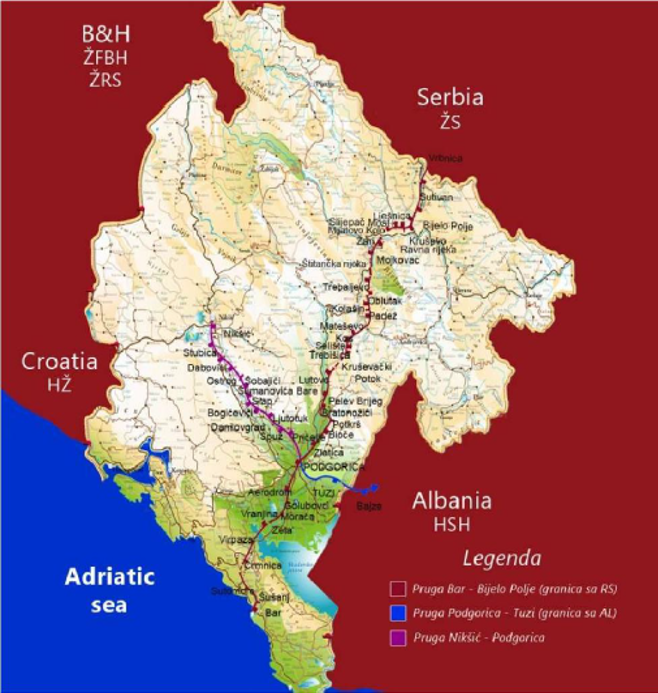Good Practices - Montenegro
Transport Development Strategy of Montenegro
Current Transport Development Strategy of Montenegro was prepared in 2006 and EU Delegation to Montenegro has contracted external experts for the project “Preparation of the Transport Development Strategy – Montenegro” (EuropeAid/132633/C/SER/multi, Contract No. 829-4147). At the moment the draft version no 1 is available and the following text is part of this report.
“The Transport Development Strategy (TDS) of Montenegro is targeting to support the improvement of the economic efficiency, safety, accessibility and environmental sustainability of the country’s transport system whilst ensuring a seamless integration of the transport sector, as well as national and EU policies.
The TDS sets five high-level (strategic) objectives, which reflect the vision for the country’s future transportation system.
The objectives are the following:
-
Economic Welfare: Achieve economic efficiency and financial sustainability and support economic development.
-
Safety and Security: Improve safety, security of people and goods in the transportation sectors.
-
Accessibility, Performance of Operations and Quality of Services: Provide maximum possible accessibility, offer quality transportation services and maintain an adequate performance in operations, as a whole and with respect to its individual elements.
-
Environmental Sustainability: Minimize carbon footprint, noise and impact to the natural, historical and socio-economic environment
-
EU Integration: Policies and a core transportation network, which are fully compatible and integrated to EU mandates.
In the forthcoming years, Montenegro will need a transport sector, which will efficiently support the country’s economic development and ensure the socioeconomic prosperity of its citizens. In this context, the country’s transportation system is expected to offer high quality services, meaning that its performance of should be improved and maintained, under possibly limited resources and operational constraints. This implies that economic efficiency and financial sustainability of Montenegro’s transportation system development and operations should be ensured” (source: Transport Development Strategy Report, Version 1 (Draft) - Dr. Antony Stathopoulos, Dr. Konstantinos Kepaptsoglou).

The Montenegro Rail Network (Source: MTMA)
3. Challenges and barriers in implementing /introducing selected good practice and respective ways used in order to overcome or limit risks
Over 48% of Montenegro’s rail infrastructure has been rehabilitated in the recent years and overhauling work on remaining segments is either ongoing or planned. The network is almost fully electrified (225 km out of 250 km or 90%), which is among the highest in Europe (the EU average is 52%). Maximum allowable speeds remain low and range between 50 km/h and 100 km/h while the fact that the rail lines are single track reduces their capacity and allowable frequencies of operations (source: TDS)
Future measures refer to activities for alleviating to barriers regarding rail sector include full transposition of EU legislation, facilitation of the introduction of new market players in rail services, etc.
4. Funding mechanism, cooperation schemes developed and institutional reforms made
Transport infrastructure expenditures in Montenegro have risen to over 5% of its GDP in past couple of years. Given the size of Montenegro’s GDP and public debt (which exceeds over 60% of the country’s GDP), traditional financing schemes such as loans are neither viable nor desirable. Additional infrastructure interventions and the introduction of intelligent transportation systems in the state network could yield additional funding requirements. As such, Montenegro should seek alternative funding schemes, especially in the form of concessions and public-private sector partnerships. With respect to services, railways exhibit low cost-recovery ratio and high subsidization; these are attributed to repayment needs of railway overhaul loans in the past years, as well as to deficits of revenues with respect to operating costs.
The role of the TDS is to create the path for improving and upgrading Montenegro’s transportation system and to support full alignment of the country with EU policies and requirements.
The Transport Development Strategy (TDS) will assist the Ministry of Transport and Maritime Affairs (MTMA) of Montenegro to provide a sound framework for its operations and at the same time to lay down the foundation for the future development of the transport sector in a way that is responsive to the socio-economic needs of the country, aligned with TEN-T guidelines and EU policies. The TDS will determine the condition of the various areas of transport, will define the concept of development of the transport system, establish long-term goals for the development of transport infrastructure and establish an action plan for their implementation (source: TDS).
5. Factors of success
The opportunity to use EU funds to engage EU experts in the domain of transport and the creation of modern strategy in line with EU legislation and trends.
6. Recommendations, transferability
As Montenegro is a candidate country for entering the EU, all recommendations and transferability are related to the good cooperation with EU institutions and financing strategic projects from the IPA funds.